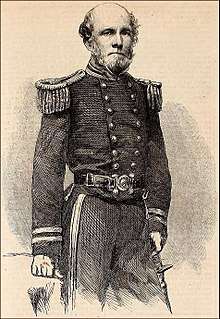Thomas Jefferson Page
Thomas Jefferson Page (January 4, 1808[1][2]–October 23, 1899[2]) was a United States Navy and Confederate States Navy officer. In 1855 his ship USS Water Witch was fired on by a Paraguayan fort, leading to the American Paraguay expedition. Page served in the Confederate Navy during the Civil War, captaining the ironclad CSS Stonewall.
Thomas Jefferson Page | |
|---|---|
 Harper's Weekly, 1859 | |
| Born | January 4, 1808 Rosewell, Virginia |
| Died | October 23, 1899 (aged 89) Rome, Italy |
| Place of burial | |
| Allegiance | |
| Service/ | |
| Years of service | 1827-1861 (USN) 1861-1865 (CSN) |
| Rank | |
| Unit | USS Water Witch CSS Stonewall |
| Battles/wars | American Civil War |
| Spouse(s) | Benjamina Price |
Early life
Page was born January 4, 1808 in Rosewell, Virginia, the fourteenth son of Mann Page. His mother, Elizabeth, was a daughter of Thomas Nelson Jr., a signer of the Declaration of Independence.[1]
United States Navy career
In 1827 he was appointed a cadet at the United States Naval Academy by President John Quincy Adams, in recognition of the services of his grandfathers and graduated with the honors of a class of forty-five members.[3]
Page served in the Caribbean, carried out a hydrographical survey of the New York coastline, and worked under Lieutenant Matthew Fontaine Maury at the Naval Observatory in Washington. Page commanded the USS Plymouth in 1849 in the East China Sea and the Sea of Japan. He battled Japanese pirates in the brig USS Dolphin at the mouth of the Yangtze River at the request of the Qing Government. Due to personal reservations about the interests of western powers in China, Page did not accompany Admiral Perry's expedition to the Far East.
Following this, Lieutenant Page commanded the USS Water Witch in which during 1853–56 he explored the South American Río de la Plata basin including its tributaries the rivers Paraná, Paraguay (and its tributaries the rivers Bermejo and Apa) and Uruguay, making the first detailed hydrological studies of the Rio de la Plata. While in Paraguayan waters his ship was fired on by the Paraguayan fort Itapirú, killing his helmsman. This was a cause of the Paraguay expedition. The United States government ordered an expedition of redress against Paraguay which, however eventually came to nothing.[4] He wrote an account of the South American expedition which was published in 1859.[5]
American Civil War
On the secession of his state, Commander Page resigned from the United States Navy to take up the defense of Virginia. During the ensuing Civil War, he became a Colonel of Artillery and commanded batteries defending the Confederate capital, Richmond. In May 1863, Page was commissioned a Captain in the Confederate Navy and was sent to Europe to purchase vessels. In the last months of the Civil War, he commanded the Confederate ironclad ram CSS Stonewall, perhaps the most powerful warship of the day. But by the time he could get his new ship from Europe to North American waters, the war was over. Captain Page sailed on to Havana, where he turned the ship over to the Spanish authorities.
Later life
After the war, Page returned to Argentina, where he engaged in politics and cattle farming; he assisted in developing the Argentine coastal defenses and enhancing the capacity and modernization of the Argentine Navy. He introduced numerous modern ideas into strategic and tactical naval formations of Argentina, making it a formidable force throughout the 19th century. He tried, unsuccessfully, to interest the Argentine Navy in a torpedo ship developed by Swedish-American John Ericsson, the inventor of the USS Monitor. Page was the secretary to the Argentine diplomatic mission to Italy.
Page and his family eventually moved to Rome, Italy where he and his family became mainstays of the American Community there and where Page was affectionately called "the Commodore." He died October 23, 1899. He is buried in the Non-Catholic (Protestant) Cemetery there, where his impressive tomb was recently restored by the Sons of Confederate Veterans. Descendants of his family, along with those of his younger cousins currently reside in Argentina, the European Union, the United States, Japan and China. Thomas Nelson Page and William Nelson Page were his younger cousins. Thomas Nelson Page served as Ambassador to Italy during the administration of Woodrow Wilson, and made it his personal mission to visit the grave of his cousin.
As a summing up, the Captain has engraved on his tomb "Thomas Jefferson Page of Virginia; Captain, U.S.N. and C.S.N., Explorer, Christian Gentleman”.
References
- Page, Richard Channing Moore (1893). Genealogy of the Page family in Virginia. Also, a condensed account of the Nelson, Walker, Pendleton, and Randolph families, with references to the Bland, Burwell, Byrd, Carter, Cary, Duke, Gilmer, Harrison, Rives, Thornton, Welford, Washington, and other distinguished families in Virginia (2 ed.). New York: publishers' Print. Co. OCLC 5393571.
- CDR Thomas Jefferson Page, Sr at Find a Grave
- "Captain Thomas Jefferson Page". Southern Historical Society Papers. 27-28: 219. 1899.
- Washburn, Charles (1871). The History of Paraguay: With Notes of Personal Observations, and Reminiscences of Diplomacy Under Difficulties, vol. 1. Boston: Lee and Shephard. pp. 373–387. (In two volumes.)
- Page, Thomas Jefferson (1859). La Plata, the Argentine Confederation and Paraguay. New York: Harper and Brothers.